Jeep Harned
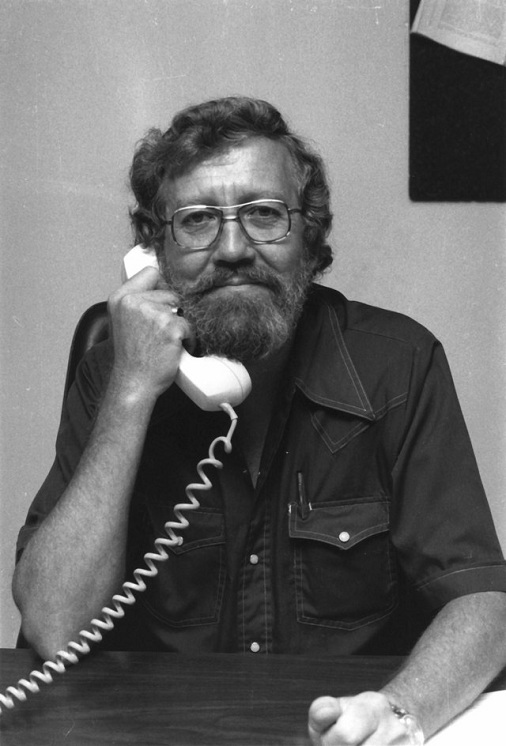
Jeep Harned is the founder of MCI, a company which began equipment manufacturing in 1959. Over the years, MCI has grown to become a major manufacturer of tape recorders and mixing consoles. More recently, the company was purchased by Sony, who was seeking an American facility to develop and produce new, ultra-sophisticated pro-audio gear. Here, in Jeep's own words, is the story behind MCI.
"I was born in Tulsa, Oklahoma on June 7, 1930, and raised in places all over the United States. My father was in the oil business and he worked for a company called Standard Oil of Oklahoma - an outfit that went under during the depression.
"At an early age I became interested in music and studied and played the cornet. I was into classical music, and acquired quite and extensive collection of classical recordings. After high school, I went to college and obtained a B.S. degree in civil engineering - I wasn't a particularly good engineering student and squeaked through school with a C+ average.
"While in college I was an ROTC cadet, and immediately after graduation in 1952, I went into the army as a second lieutenant. This was during the Korean conflict and I went through officer's basic training in El Paso, Texas, graduating 11th out of some 240 second lieutenants from universities all over the United States.
"Most of the graduates were shipped to Korea, but about a dozen of us didn't get an assignment and we wondered what was happening. We sat around Fort Bliss for about 3 or 4 weeks, until orders came down.
"It seemed that they were short of instructors in Electronics School and they were going to turn us into Electronics Instructors in 90 days. Out of our group of twelve, there was only one electrical engineer, with all the rest chemical engineers, civil engineers, mechanical engineers, etc. The Army set up a special "crash" course and ran us through it.
"As soon as we had finished the course, they had us up on the platform teaching. We covered basic electronics and then all the way through to very complex radar pulse and timing circuits, servo-systems, analog computers, etc. My classes consisted of about 50 enlisted men and officers, every day for approximately 14 months, the duration of this assignment.
"After eighteen months I came out of the army as a first lieutenant, and got a job with the Carter Oil Company (a branch of the Standard Oil Company of New Jersey). I was a "doodlebugger," which is oil slang for seismograph operator, starting as a trainee and then becoming an assistant operator. In the oil business you have to move around a lot, and I worked in two or three towns in Alabama, Mississippi, Montana, four cities in Wyoming, North Dakota, Louisiana, and finally in Tulsa, Oklahoma, where I worked in the research lab at Carter Oil's Headquarters. I stayed with Carter Oil for about a year and a half, and met my wife in Jackson, Mississippi while working for the company. I remember being in Montana, with winter coming and my wife pregnant, and deciding that the Gypsy life of the oil business was not good for a married couple, even if the pay was sensational.
"My brother lived in Fort Lauderdale, Florida at the time and he said, 'Come on down and whatever you do, you'll do great at it.' So in 1955 we moved to Fort Lauderdale and found that it was an absolute, desolate, nothing of a place. I had walked away from a very good job to come down to Florida and now I just couldn't find employment. I went to Eastern Airlines, National Airlines, civil engineering firms, and every place that I could think of to apply for a job, and there just wasn't anything available. So I borrowed $8,500 from my brother and opened a store called Music Center Inc., joining the then-infant high fidelity business. I sold equipment like AR, KLH, Fisher, McIntosh and, like most small businesses, I was underfinanced. I started doing service work and soon discovered that I made a lot more money from fixing other people's gear than I did selling it. Soon I was fixing amplifiers, tuners, record changers. . .just about anything.
"In 1959 Jack Sauls, a good friend of mine who is now deceased, walked into the shop with a record album. Jack had a great pair of ears and had just picked up this album at a recording studio in Miami. He wanted my opinion of the sound, so we put it on the turntable and we listened. It was the worst sounding record I had ever heard - just full of distortion. Jack said that a man by the name of Mack Emerman had just built this studio and had put everything that he owned into it. The studio had all custom built equipment and obviously Mack was having some problems with some of it; Jack said that he would arrange a meeting to see if I might be able to help him out. I said, "Okay," loaded all my test equipment into my car and we went down to Criteria. Mack's new studio was very pretty. The equipment was flat to DC to daylight, but some of it was oscillating and motorboating, which caused considerable audio distortion. I had a Heathkit I.M. analyzer that I tweaked up, and it could read I.M. distortion down to about .05%. So I brought in my test equipment and started to measure the performance of the console, tape recorders and power amplifiers. The console was custom built with 16 inputs and three outputs, the tape recorders were three track 1/2 inch, and the power amplifiers were also custom jobs with four KT88's in push-pull parallel which would have provided about 120 watts.
"After considerable effort in attempting to make distortion measures on the console, I was finally able to pad down the signal into the mike preamp (which had about 100dB of gain) far enough to prevent total overload and get a reasonable fader setting while delivering +4 output. At this point I was measuring 14% distortion before reaching the tape machine, with equalization flat and everything else at nominal. I then measured power and distortion out of the custom built power amps. The best one put out something like 14 watts at 10% and the worst one was putting out 1/2 watt at distortion so high that it was unmeasurable. It was at this point that both Mack and I realized that he had some problems. We discussed the meaning of distortion and its effect on the audible quality of a recording at some length and Mack made the decision to rebuild all the electronics in his control room. The goal: to bring distortion down to reasonable levels of approximately .1%. With my experience in electronics I felt that I could improve the performance of some of Criteria's equipment, and I told Mack that I could design some better sounding gear for his studio. I knew that this was going to be a learning experience for me as I didn't know anything about recording consoles, so I asked Mack to be patient with some of my design efforts. Well, I got busy and started designing new preamps, new line amps and power amps, and after about a year we had rebuilt almost everything at the studio - including the record cutting chain. After these improvements were made Criteria started on its first big string of hits.
"Mack and Criteria got a reputation for getting a really solid low end from the equipment that I had designed and built. Finding that decreasing the feedback increased stability at just a modest compromise in distortion, I simply designed some very stable tubing circuitry with a little higher than the 'normal' distortion that others were getting with massive amounts of feedback. I was a good tube designer, and I also provided service for my equipment after I had built it.
"By the early 1960's I had people asking me to build consoles and other kinds of professional audio equipment, and I was always able to use Mack and Criteria as a combined sounding board 'test bed' for new design concepts. I built a little mono mixer for a guy in Jackson, Mississippi by the name of Bob McCree, and he cut a bunch of hit records on it. He just sat there in his little room in his house cutting hit after hit with this little mono mixer and that Altec A-7 stuck in his ear. I remember that he and his two partners came down and negotiated with me for three days on the price of that mono mixer, a unit that I built in about four days and sold to them for about $1,000.
"Thinking that this business was really something, I'd grab a chassis and start punching holes in it, put in and wire a bunch of tube sockets, and go. I had designed some good sounding circuits that really worked, and I did this for about eight or nine years.
"By about 1964 or 1965, I was pretty tired of the hi-fi stuff, 'cause it was a pain and I never made any money on it. I guess I was a poor salesman, because I always told people what I thought about the stuff. In those days most of it was pretty bad.
"I had named my store Music Center Inc., and people were always calling me for guitar picks and sheet music. . .so in 1965 I went to the state of Florida and changed the name to MCI Inc. Then I was hit with a couple of burglaries that pretty much eliminated my inventory. One of the guys who burgled the place was an employee of mine, a technician who had been working for me for three to four months. He made a duplicate warehouse key, and one night just went in and cleaned it out.
"At this point I owed $24,000, so I wrote all of my creditors and told them what my financial condition was, and that I intended to pay them back with interest if they would just be patient. I think that it took about six months, a period when I was doing industrial type sound work, installations, repairs and building custom equipment. At about the same time I got out of the retail business in one fell swoop by taking every piece of equipment that I had left and all the records in the shop and stacking them up by the front door with a sign that said "fifty bucks takes all." The first guy into the store that morning almost fainted, but he said, "Don't sell it! I'll be right back." He was gone about twenty minutes and came back with fifty dollars, loaded the stuff up and went away.
"I got into the tape recorder business in an interesting way. I had built a console for Sidney Nathan of King Records in Cincinnati and he, Mack Emerman, and Bob Richardson had a bunch of Ampex 350 tape recorder with transports that still ran well, but electronics that were on the verge of quitting completely. So in 1968 Sid, Bob and Mack got together and hired me to design and build some new "solid state" electronics for the old transports. My electronics proved to be quieter, had lower distortion, and they didn't have the 'Bias Rocks' common to so many earlier designs.
"I filled this order for 100 units and I thought that would be the end of it, but when the word got around the industry that there was this guy in Florida building these 'solid state' electronics, a lot more people became interested in them. All of a sudden I'm sitting there looking at orders for two of three hundred of these things. People bought my electronics to use with the older transports, and we continued to sell these for several years. And that's where it all started for MCI in the tape recorder business.
"Tom Hidley, who was chief engineer at TTG Recorders [in Hollywood] was one of the guys who had heard about the electronics. One night I got a phone call at home and he introduced himself and asked, 'Have you ever made a twenty four track?' I said, 'No, we've made 16's and 8's, but never a twenty four.' He asked 'Is there any reason why I couldn't make a 24 track machine?' and I assured him that my electronics would work with a twenty four track, so he gave me an order for 24 electronics assemblies and associated power supplies - and then he asked me to find him some heads.
"I called up Lipps and told them about the special head configuration that we wanted, along with the coil inductance, gap lengths, and mechanical specifications. Then we built the electronics and shipped them to Tom, who took an Ampex 300 transport and converted it to handle two inch tape - which many people were doing in those days. To our knowledge, that TTG machine was the world's finest 24 track recorder. Tom put the ideas together and assembled it, and I have a picture of Wayne Neweton leaning up against that machine.
"At this time Wally Heider had all the sixteen track machines in Southern California, and now there was this new guy on the block with twenty four tracks. Naturally this blew the whole scene apart and people were soon scrambling to get their hands on twenty four track machines like it was a gold rush. It took Ampex and 3M a little time to react and get their 24 track machines on the market, and in the meantime we were building and selling electronics like crazy.
"We designed and built our first tape transport around 1970 or '71, which was the JH 10 16 track tape recorder.I did all the mechanical and audio design work and Jim Strickland did the tape tensioning and control logic design. Jim now heads up Acoustat, one of the world's few manufacturers of full range electronic loudspeakers.
"We introduced the JH-10 recorder at the A.E.S. Convention in 1971. Initially the machine was available as an 8 track or a 16 track, and later we offered it as a 24 track unit as well. MCI didn't start making a series of 1/4" machines until 1977, when we incorporated a new DC transport design.
"At the 1972 convention we introduced our "AutoLocator," which could ramp down to the "0" point with no overshoot. Since it was the first really accurate locating device, this original AutoLocator was the hit of the show. The key to its accuracy was an "up-down" counter circuit we had developed. We should have patented it, because today almost every one of our competitors uses this approach.
"1972 also was the year when we started building our first "production" console series, JH-400's. This design evolved from some of Dave Harrison's ideas. I had known Dave from the days when he had worked at Criteria, and he also played in Wayne Cochran's band in Miami. Then he did studio maintenance for Sid Nathan at King Records, and worked his way up to become studio engineer and manager. Sid also owned part of a recording operation in Nashville and transferred Dave there. When Sid died, the studio was wound down and went out of business, leaving Dave to start his own company, The Studio Supply Company.
"At this time our dealer in Nashville was Dan Flickinger, but we dissolved our relationship after his accident. I then made Harrison's Studio Supply Company the Nashville dealer for MCI tape machines and he did quite well at it. Shortly thereafter Dave approached me about designing a new kind of console. He had some ideas, and I told him that if he design it, MCI would build it. Dave came down to Florida and started drawing and laying tape, and we built a run of six consoles. These boards were quite unusual for their time - the track assigns were in-line with the monitor and main channel fader. The console was similar to Flickinger's earlier concept except that his boards had the track assignments off to the right of the channel area. After the first run of six, I decided to do some additional work on the design - changing some of the metal work and adding other circuitry. We also incorporated the Harris 911 IC op-amps which lowered costs and made the product more manufacturable. All in all, I think we built about two hundred of those 'Series 400' consoles between 1972 and 1977, at which time we brought out the JH-500 Series. The 500 Series had improvements such as a more elaborate equalizer with two mid-band EQ sections, high and low pass filters, more sends, additional returns, plasma displays for VU indicators, communications facilities and so forth. Now in a transfomerless version, the JH-500D is still in MCI's console line.
"All the while MCI just kept growing and getting bigger. We brought out the "600 Series" on consoles, and new tape transport designs. Later we developed an all DC transport design with a DC capstan motor and DC motors for spooling. This transport was introduced in 1975 on the JH-100 tape recorders series, which we are still building today in updated versions.
"Most tape transports available during the mid seventies still used big AC motors for capstan and reeling functions, relays for control logic, and there was a lot of AC floating around under the transport which often caused hum problems. MCI was the first to take the big step and design an all DC, servo controlled transport for use in recording studios, using low level control logic and op-amp circuitry. Today , almost all professional recorders follow this design approach first introduced by MCI. The reliability of these machines went way up, and their performance improved dramatically. These all DC transports would hold constant tension from the front of the reel to the back, eliminating the pitch and timing errors common to older designs. If a machine was aligned properly, you could record 10kHz on the head of the tape, read it with your frequency counter, and then flip the reels over (placing the tone at the end of the reel) and read it on the tail and it will be within an accuarcy of 2 Hertz (2 parts in 10,000).
"MCI experienced very rapid growth during these years. We were constantly buying a building, moving into it, outgrowing it in six months or so, and then buying anouther building. At one time we had manufacturing in three different builings, and we would run around picking up PC boards in one building, take the iver to another building where the machines were assembled, and then bring the sheet metal over from yet another building. It was really something.
"We put in a precision sheet metal shop that is probably the most complete in the state of Florida. We had to put in our own machine shop because we required a precision that nobody else could give us, and we outfitted that shop with the latest in numerically controlled equipment, punches, mills, lathes, and so forth.
"Today, we build our own motors, make our own faders, printed circuit boards, have our own paint shop, do our own silk screening. . .in short we have almost completely integrated manufacturing capacity for professional audio equipment. We now have about 410 employees and our factory occupies about 200,000 square feet.
"As most of the people in the industry know, MCI was purchased recently by the Sony Corporation of America. I think that things that attracted Sony and the others who had desired to purchase the company over the years was our strength in the marketplace and our complete manufacturing facilities. Sony and MCI make a good fit. Sony is very heavy in audio because that is the field that they started in. Their first product was a tape recorder, and all of their principles are audio people. They've made it big with video, but they've always had a great love for audio and their video needed our audio to round out their packages. This made the two companies fir together very nicely.
"With respect to digital tape recorders, Sony and Struder decided on the same standard. Now with Sony and MCI being the same company, there are three major tape recorder manufacturers using the same digital standard format. Ampex has not revealed what they are going to do as of yet, while 3M and Soundstream have their own digital tape recording formats.
"Sony has asked us to develop some very, very sophisticated pro-audio equipment. They're supporting us with engineers from Japan and our engineering staff has doubled and I wouldn't be surprised if it tripled within a few more months. These things that we are working on are heavy design projects and they're going to be exciting. When some of these products start to come out in the next year or so, I think the pro-audio guys are really going to stand up and cheer."
Photos and foundational text courtesy of Larry Lamoray and Carla Harned, of MCI.
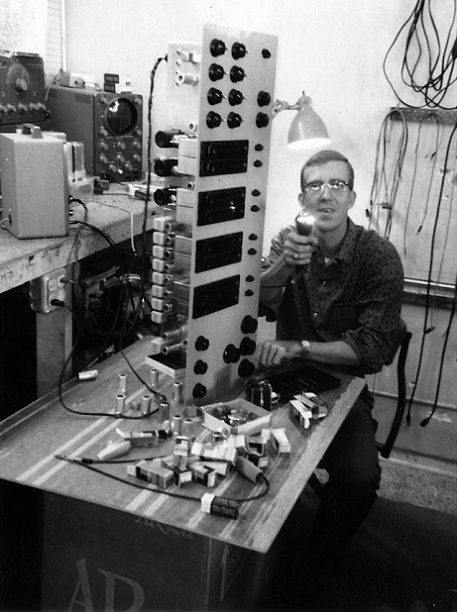
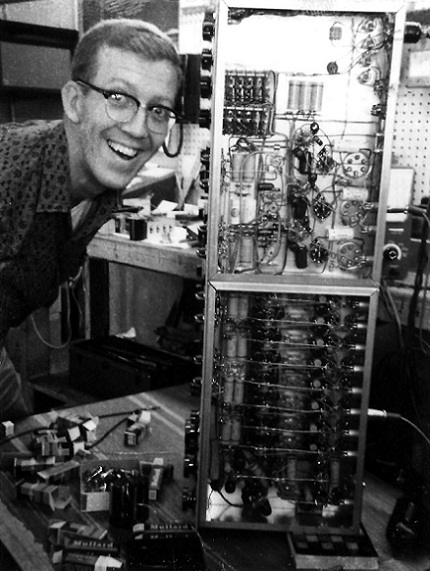
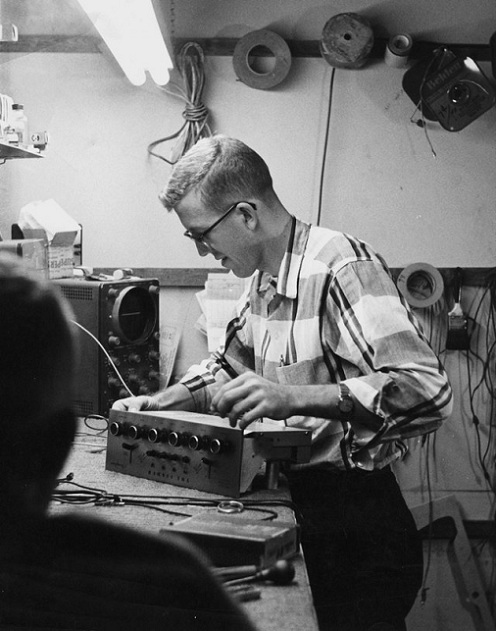
Jeep Harned's Early Years. Photos courtesy of Larry Lamoray and Carla Harned, of MCI.
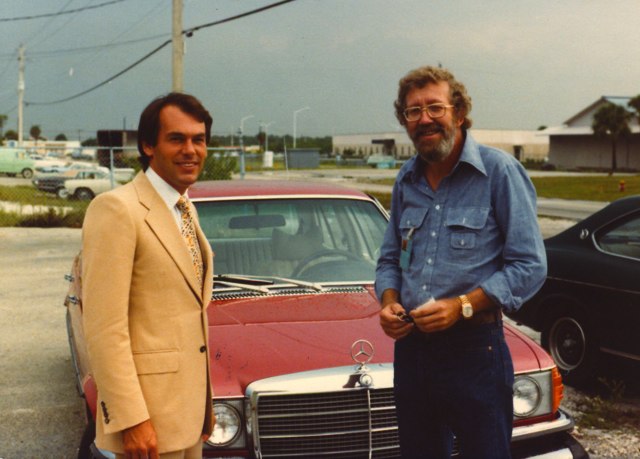
Michael Shulhof and Jeep Harned. Photo courtesy of Larry Lamoray and Carla Harned, of MCI.
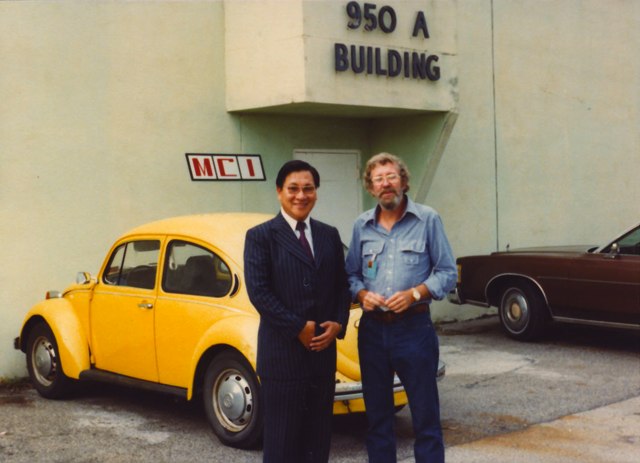
Norio Ohga and Jeep Harned. Photo courtesy of Larry Lamoray and Carla Harned, of MCI.
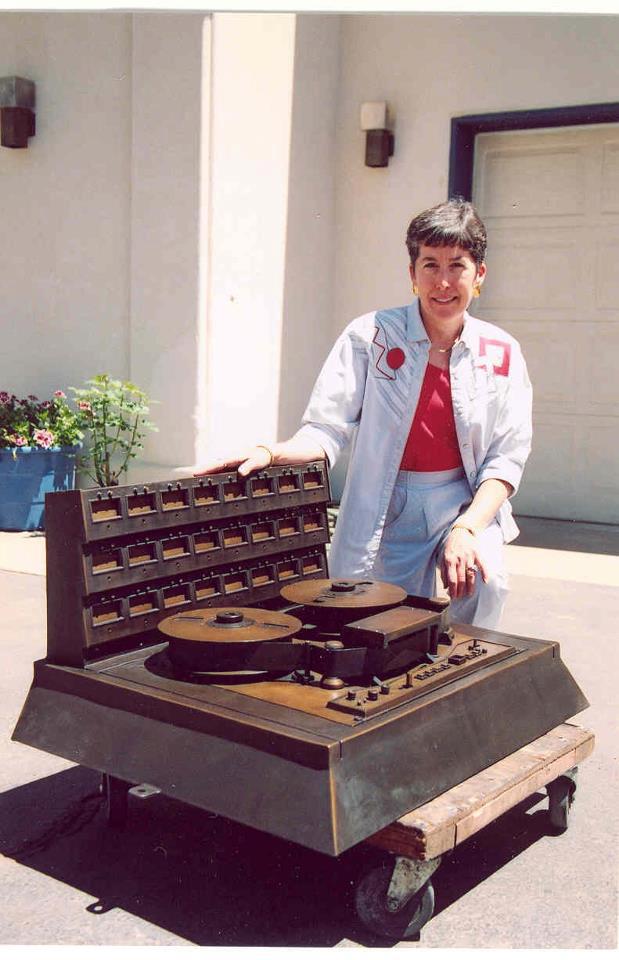
Jeep's tombstone. Photo courtesy of Larry Lamoray and Carla Harned, of MCI.
Write about Jeep Harned!
Do you have content or pictures, to add, of Jeep Harned? Do you just want to say "Hello!"? Please feel free to Share it, here!
What other Visitors have said about Jeep Harned!
Click below to see contributions from other visitors to this page...
Jeep Harned and Chuck Kirkpatrick at a Criteria reunion party, late 90's... Not rated yet
Jeep Harned and Chuck Kirkpatrick at a Criteria reunion party, late 90's...
Chuck Kirkpatrick
Return from Jeep Harned to Recording Engineers, Producers and Associated Recording Industry Professionals
|


